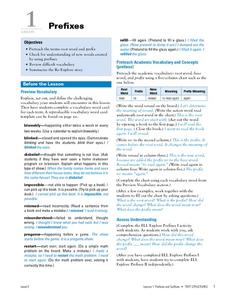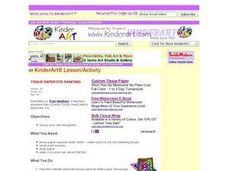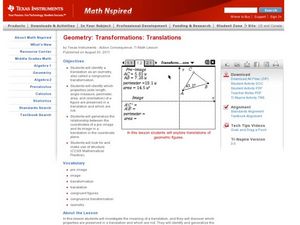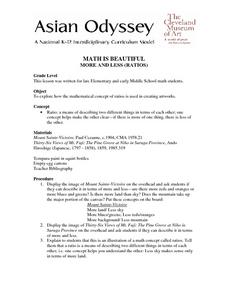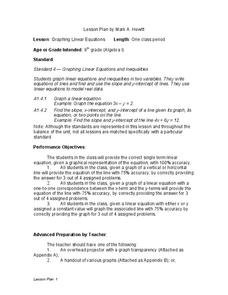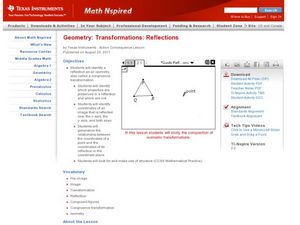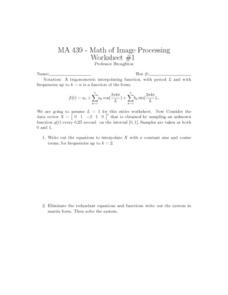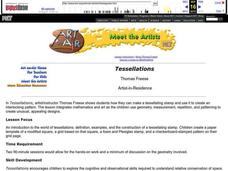National Council of Teachers of Mathematics
Seeing Music, Hearing Waves
In this music activity, 11th graders incorporate fractions into their music scales and counting scales. They listen to the music being played and relate it to sine waves reviewing the trig function. There are 11 questions involving sine...
Curated OER
Scaling Up Art
Students measure a sculpture of a human and measure other students. They determine the average size of humans and create a life size image of the sculpture. They work with percentages as they create the images.
BioEd Online
Good Stress for Your Body
Stress the importance of the different types of pressure our mind and body experience in a lesson about how certain types of stress are actually necessary and good for our bodies. As astronauts and people with injuries can attest, not...
Curated OER
Earthquakes: Fifth Grade Lesson Plans and Activities
After learning about P waves and S waves, fifth graders view the intensity of earthquakes by examining seismographs and images of earthquake damage. Young scientists then forecasting future quakes by analyzing data about...
Curated OER
Three Methods for Using Quadratic Functions to Model Data
In this modeling data activity, students use quadratic functions to model data using three different methods. This activity provides explanations and an example. Additionally, students are given the steps to find the maximum...
Perfection Learning
Prefixes, Suffixes, and Root Words/Base Words
Get your class on track with their affixes by covering prefixes, suffixes, and root words in depth. This short three-lesson unit includes vocabulary lists to study, detailed plan procedures, and some accompanying worksheets.
Curated OER
Tissue Paper Dye Painting
Use tissue paper squares to create collage art. Young artists discuss colors as they place and glue each piece of tissue on the paper. Tip: Cut out large basic shapes instead. Have the class create images using the tissue...
Curated OER
Aboriginals
Students are read a book about aboriginal perspectives. They answer questions and practice words with the letter "g". They participate in math drills practicing their counting as well.
Curated OER
Scaling Down Art
Students change the scale of a work of art using ratios, percentages, and proportions. While this is technically an art lesson, there is quite a bit of mathematics involved in converting to the correct scale.
Curated OER
Math Word Problems: Reading Bar Graphs
In this math word problems-reading bar graphs instructional activity, students analyze the bar graph and answer six questions about the data in the graph.
EngageNY
Rotations, Reflections, and Symmetry
Lead your high school class on a journey through the world of symmetry and reflections as you discuss geometric principles. Pupils differentiate between reflections and rotations, explore rotational symmetry, and investigate how to...
Curated OER
Exploring Arrangements of 2, 3, 4, and 5 Cubes
Students use problem solving skills to create various models of tricubes, tetracubes, and pentacubes. They classify the cubes into various groupings and identify them as mirror images, regular arrangements, and irregular arrangements....
Curated OER
Symmetry that is Basic and Beautiful
Students explore lines of symmetry. In this symmetry lesson, students divide and combine shapes along basic lines of symmetry. Students explore symmetry in real life objects.
Curated OER
Changing Images of Childhood in America: Colonial, Federal and Modern England
Students compare and contrast maps of New Haven, Connecticut from today and the past. After taking a field trip, they draw sketches of the types of architecture and discuss how the buildings have changed over time. They read journal...
Curated OER
Transformations: Translations
Students perform transformations and translations using polygons. In this geometry lesson, students perform transformations on a coordinate plane. They identify the image and pre-image of each figure.
Curated OER
Transformations and Rotations
Students define and identify transformation and rotation. In this geometry instructional activity, students define rotations as congruence or isometry. They find the coordinates of an image and pre-image.
Curated OER
An application of the Parallax Effect
In this parallax effect worksheet, students observe 2 photographs taken of an active area of the sun by 2 STEREO satellites and 1 photograph taken of the same active area of the sun by the SOHO satellite. Students observe the shift in...
Curated OER
Chandra Explores Angular Size
In this angular size learning exercise, students read about how astronomers determine the size of objects in the sky by using their angular size. Kids are given equations that allow scientists to convert the angular size into kilometers....
Curated OER
MATH IS BEAUTIFUL: More And Less
Students use tempura paints and mixing techniques to explore the mathematical concept of ratios in this cross-curricular late-elementary/ealy middle level Math lesson plan. A homework assignment is included.
Curated OER
Graphing Linear Equations
Ninth graders review the information that they have already learned
with regard to linear equations and graphical representations. They then assist in combining equations with a graphical element and complete various graphs with this...
Curated OER
Modeling a Planetary Nebula
In this modeling a planetary nebula worksheet, students use a diagram to calculate the intensity at different radii from the center of the nebula. Students use the Pythagorean Theorem to determine the distance between two points on the...
Curated OER
Transformations: Reflections
Students perform transformations on their graphs. In this algebra lesson, students identify the pre-image and image. They find and identify congruent shapes and isometry.
Curated OER
Interpolating Function
In this interpolating function worksheet, students solve 7 different sets of problems that include determining the interpolating function of each. They write out the equations to interpolate with a constant sine and cosine terms. Then,...
Curated OER
Tessellations
Students learn and review basic geometric terms, definitions, and theory, including regular polygons, lines, angles, points, etc. They make a tessellating stamp and create a repeating work of art.





